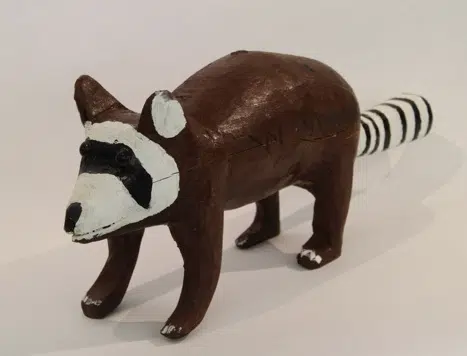
“Raccoon” by Wesley Merritt, 89.9.2, wood, no date, Ruth & John D. West Collection at the Rahr-West Art Museum
The following article was written for the Art Forward series by Diana Bolander, Assistant Director/Curator Rahr-West Art Museum.
Many things in the Rahr-West Art Museum collection present a bit of mystery. I especially would love to have access to Ruth West. I’d ask why she made some of the collections decisions she did and how she got connected to some of the artists, as some seem rather random. One example in the Rahr-West Art Museum Collection is object number 89.9.2, a wood sculpture of a raccoon by Wesley Merritt. It is roughly carved, not highly finished, and the paint is not applied with traditional finesse or expertise. Its little glass eyes (literally the same eyes taxidermists use) stare out blankly. Despite this incongruous presentation it has a charm that cannot be denied.
At the time of donation in 1989, the artist of the raccoon sculpture was unknown to the Rahr-West Art Museum staff. In 1993, curator Dan Juchniewich communicated with Saginaw Valley State University and identified Wesley Merritt as the artist. There is not much else in the file except for information on Jim Dine, whose work was donated at the same time.
We live in the vicinity of the John Michael Kohler Art Center’s Art Preserve in Sheboygan and the uniformly positive reception of their oeuvre leaves no doubt that the interest in and respect given to artist environments, self-taught, and outsider artists in Wisconsin is significant. We give respect to all types of creativity in the Great Lakes region, not just the traditional. Manitowoc’s own Rudy Rotter compulsively created thousands of works of art until his death in 2001 and his legacy is significant if not well understood. Yet, I was surprised to come across this work in our collection. Outside of Rudy Rotter’s work with its local connection, the Museum doesn’t hold much folk or outsider art in our collection of almost 3,000 works. I have always been interested in the work of self-taught and outsider artists, although it was not typically included in art history curricula. I am by no means an expert on folk art, but I am quite familiar with Wesley Merritt.
In 2010, I was midway through my tenure as the Curator of Education and Interpretation at the Dennos Museum Center in Traverse City, Michigan. I had the opportunity to curate an exhibit of work by self-taught artist Wesley Merritt, whose home and workshop was actually only about 20 miles from where I grew up. The majority of work in the exhibit was on loan from local artist and collector, Dewey Blocksma, a talented artist in his own respect. Much of my knowledge is adapted from a catalog essay I wrote for that 2010 exhibit. You can read more about the 2010 exhibit and the Dennos Museum Center (a must-see in the Traverse City area) at https://www.dennosmuseum.org/art/exhibit-archive/2010/merritt.html. I may never know why this ended up catching the eye of Ruth West, but knowing more about Merritt helps provide context to a work that not everyone might value upon first glance.
Anson Wesley Merritt was born March 10, 1926 in Midland, Michigan. Known as Wesley Merritt, he lived most of his life in mid-Michigan, most notably in Shepherd and Mount Pleasant. As a child, Merritt had spinal meningitis, which kept him from school for prolonged periods. Merritt had a fourth-grade education and could not read or write very well, though he could write well enough to sign his work, create signs for his shops and yards, and label his materials.

“Raccoon” by Wesley Merritt, 89.9.2, wood, no date, Ruth & John D. West Collection at the Rahr-West Art Museum
Throughout his life, Merritt worked as a boiler-tender, janitor, beet farmer, handyman, and junk seller. His stepfather was also a junk seller and Wesley probably learned the trade from him. In the last few decades of his life, Merritt supported himself and his wife, Mabel, by selling his carvings and secondhand goods.
Merritt is often described as a self-taught artist. He never received academic training as an artist nor was exposed much to the social-cultural mainstream. Indeed, he rarely traveled more than a few miles from his home. Merritt’s work though was shown by several galleries during his lifetime: Tamarack Gallery in Omena, Michigan and Nautical Antiques of Lake Leelanau, Michigan. His work likely traveled further than he ever did. Merritt produced several hundred folk sculptures of animals, Native Americans, pioneers, farmers, and biblical characters between 1960 and his death in 2004. He had a compulsive need to create sculpture, believing that his talent was a gift from God that should not go to waste. In 1981 he said, “I’m most generally happy through Christ. Without Jesus, we wouldn’t know how to carve. If it’s the will of God, come summer we’re gonna have a lot of strange things out here [his workshop and yard].”
Like the work of many self-taught artists, Merritt’s work is representational and narrative. Figures and animals are carved to be true-to-life and usually life-size while retaining a naïve charm about them with some distortion and exaggeration. Merritt referred to his style of carving as “authentic” and said in a 1988 Saginaw News article, “People want them rustic. They look like they’re ceramic if they’re too good.” His carving style fits solidly into the American Folk-Art carving tradition and is reminiscent of folk artists Filip’ Beníto Archuleta and Leroy Ramón Archuleta of New Mexico.
When starting a sculpture, Merritt sketched the shapes onto cardboard and then cut them into templates. He then traced the shape of the template onto the log or block of wood. Merritt used a chainsaw to carve the initial shape and then used tools and sandpaper to finish the carving. He primarily carved with pine or cedar and used house paint to decorate his work.
Merritt signed the sculptures with his initials, “WM.” Usually, he used a blunt screwdriver, chisel, or disc tool to carve the signature, leaving a thick, deliberate line. Signatures can be found on the bottom of works, as well as in prominent places such as the bellies of standing animals becoming an integral part of the design of the work, as we see in this raccoon.
Though I will never know why this raccoon is in the Rahr-West collection, I am happy to see it and share Merritt’s story. It feels like a little piece of home for this recovering Michigander. I am thankful for Ruth West, the Little Gallery, and all the other individuals and organizations that have donated work to the eclectic and mysterious collection of art here at the Rahr-West Art Museum.
It’s a unique place in our own backyard with works from artists ranging from masters Georgia O’Keeffe and Marc Chagall to local artist Ron Stokes to folk artist Wesley Merritt and just about everything in between. Come see us this winter!




